Patrick O'Brien, a professor of Illustration at Maryland Institute College of Art (MICA), discovered that there wasn't enough interest in his class called “Oil Painting for Illustrators.” So he redesigned the class, calling it “Creature Creation Workshop,” and the class filled up right away.
Viewing: Blog Posts Tagged with: Art Schools, Most Recent at Top [Help]
Results 1 - 25 of 59
Blog: Gurney Journey (Login to Add to MyJacketFlap)
JacketFlap tags: Art Schools, Add a tag
Blog: Gurney Journey (Login to Add to MyJacketFlap)
JacketFlap tags: Animals, Art Schools, Add a tag
Great schools are made up of great teachers, and one of them is Gary Geraths, who teaches animal drawing at Otis College of Art and Design in Los Angeles. He has brought in camels (and belly dancers) to his class so that students can draw them directly from life.

Understanding what's going on beneath the surface is not always obvious, so Gary does demonstration drawings of the skeleton and the surface features.
He brings the students to the Page Museum, where they can sketch from articulated skeletons of animals that fell into the nearby La Brea Tar Pits.
| James Gurney visits Gary Geraths (center) and Bill Eckert at Otis in 2010 |
Blog: Gurney Journey (Login to Add to MyJacketFlap)
JacketFlap tags: Animation, Art Schools, Add a tag
In 1935, Walt Disney wrote an eight page memo to art teacher Don Graham outlining his ideas for how to train an animator.
 |
| Rico Lebrun works with Eric Larson as he draws a live deer in preparation for Bambi from Eye-Likey |
"I have often wondered why, in your life drawing class, you don't have your men look at the model and draw a caricature of the model, rather than an actual sketch. But instruct them to draw the caricature in good form, basing it on the actual model."
"In [drawing the model] lifting, for example - or other actions - we should drive at the fundamentals of the animation, and at the same time, incorporate the caricature. When someone is lifting a heavy weight, what do you feel? Do you feel that something is liable to crack at any minute and drop down? Do you feel that because of the pressure he's got, he's going to blow up, that his face is going to turn purple, that his eyes are going to bulge out of their sockets?"
Disney observed that young animators often dwelled on the individual parts of the body that they were animating instead of the expression of the overall pose. To better understand expressive poses, he suggested setting up a translucent screen with the model behind the screen, seen only by the shadow silhouette cast by a spotlight behind, which was in fact an old parlor game.
He goes on to suggest ideas for teaching about the components of facial expression, staging, music, dialog, and the understanding of what drives the movement of the figure. "The driving force behind the action is the mood, the personality, the attitude of the character - or all three. Therefore the mind is the pilot."
In this video, Disney talks about how his in-studio training program went beyond the static poses that were taught in typical art schools by focusing on the flow of movement, action, and reaction. (link to video).
Walt's interest in an in-house studio was initially inspired by animator Art Babbit, who brought his fellow artists to his home to do figure drawing. Here's more about Art Babbit's role in animation education at Disney in the 1930s.
Artist Rico Lebrun was brought into the program later in the 1930s, primarily to help with Bambi. Read about his Disney art classes here.
Further reading
Online:
Full text of Disney's letter to Don Graham
Books:
The Illusion of Life: Disney Animation
Drawn to Life: 20 Golden Years of Disney Master Classes: Volume 1: The Walt Stanchfield Lectures
The Animator's Survival Kit by Richard Williams
Blog: Gurney Journey (Login to Add to MyJacketFlap)
JacketFlap tags: Portraits, Figure Drawing, Art Schools, Add a tag
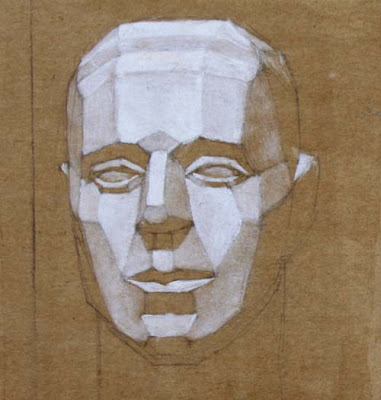
This was the method taught in a seminar I took from Art Center instructor Paul Souza, and here's an exercise I did in that class, scumbling white oil paint over chip board sealed with shellac.

In truth, there is no single ideal plane head, and even an individual model's face can be analyzed in various ways.
Blog: Gurney Journey (Login to Add to MyJacketFlap)
JacketFlap tags: Portraits, Watercolor Painting, Art Schools, Add a tag
Here's Dennis afterward with his daughter Evie, a student at Hartford. The painting is in a Moleskine water media notebook
If you're a high school student interested in studying illustration, I recommend the program at Hartford. It's led by not only Dennis Nolan, but also Bill Thomson, and Doug Anderson. Their program is strong in observational drawing and painting, and the seniors create their own children's picture book from start to finish, and they also have the opportunity to study animation. The illustration program is very popular; this year they have the largest sophomore enrollment ever.
-----
Dennis Nolan's faculty page at Hartford Art School
Previous post on the Hartford Art School
Blog: Gurney Journey (Login to Add to MyJacketFlap)
JacketFlap tags: Art Schools, Add a tag
D. Peters asked: "Ok, random question. A bunch of art teachers are debating whether or not learning how to use a ruler and how to draw things to scale is still a needed skill for today's artists. Some argue that with technology, we no longer have the need to learn how to scale up or down by hand. Others say that even with the technology, there is still a need for artists to learn how to draw and shape to scale by hand. Opinion?"
| Jeanette in my basement studio, which I occupied 1985-1991 |
I suppose teachers of art rightly worry about which skills are more worth teaching than others, given the limited time they have to prepare a group of graduates for the real demands of a job marketplace. Most art teachers I've asked about this question have told me that both traditional skills (such as perspective) and computer skills (such as Google Sketchup) are worth learning, but the problem is the limited class time available to teach it all. Many digital animation studios want animators who have some training in hand-drawn or stop motion animation because it gives their digital work more grounding.
Blog: Gurney Journey (Login to Add to MyJacketFlap)
JacketFlap tags: Art Schools, Computer Graphics, Add a tag
On Thursday I visited the Worcester Polytechnic Institute (WPI) in Massachusetts as a guest of the department of Interactive Media and Game Development (IMGD), where I gave a lecture on Worldbuilding.
The IMGD program at WPI is designed to provide students with both programming expertise and art knowledge so that they're well rounded in their approach to interactive design.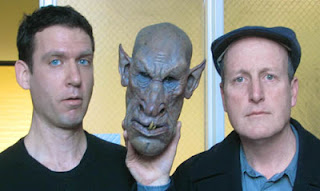 One of the professors is Britt Snyder (left, with a Jordu Schell sculpt between us). Britt has worked as an artist in the field of video game development for the past 13 years, with clients like SONY, Blizzard, Liquid Entertainment, Rockstar, THQ, and many others.
One of the professors is Britt Snyder (left, with a Jordu Schell sculpt between us). Britt has worked as an artist in the field of video game development for the past 13 years, with clients like SONY, Blizzard, Liquid Entertainment, Rockstar, THQ, and many others.
He teaches 3D modeling, digital painting, and concept art.
WPI was one of the first to develop a program in game design, and is one of the top-ranked academic programs in the field. Since the department is part of a larger engineering school, there's always a focus on blending art and technology, with an eye on fostering close working relationships between artists and programmers.
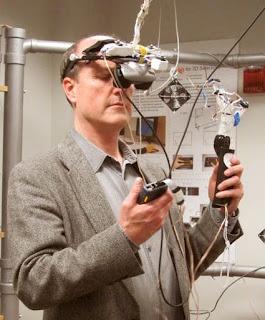 Students get to jump right in and participate in hands-on projects and collaborations, creating games, virtual environments, interactive fiction, art installations, collaborative performances. They are encouraged to invent entirely new forms of media.
Students get to jump right in and participate in hands-on projects and collaborations, creating games, virtual environments, interactive fiction, art installations, collaborative performances. They are encouraged to invent entirely new forms of media.Blog: Gurney Journey (Login to Add to MyJacketFlap)
JacketFlap tags: Dinotopia, Museum Visits, Art Schools, Add a tag
Blog: Gurney Journey (Login to Add to MyJacketFlap)
JacketFlap tags: Color, Art Schools, Color and Light Book, Add a tag
We experimented with your method of gamut masking and mixing color strings. We used pages 123-131 in Color and Light, and also referenced pages 106-107 and 116-117.For the exercise I brought in some simple photographs for them to copy, because I wanted to take the drawing element out of it, so they could concentrate on the color scheme. On the morning of class I went to the MICA library to find a color wheel to use.
In flipping through all the books about color, I could not find a single good color wheel that went to grey in the center. So we had to use the small color wheel in your book on page 75. We used index cards and tape to make the masks. As you can see, some students' first instinct was to photograph it with their phone and bring it back to their seat.
I had each student draw the subject twice. We did one small painting in one color gamut, and then their homework is to do another painting of the same scene in the other gamut. Pretty much exactly what you did in your video with the CircusCircus sign.
And now I've been inspired to incorporate these ideas into my own painting as well. I'm working on a New York 1940s maritime scene that would be perfect for a cool gamut.
Thanks for the great ideas! ---Patrick O'Brien, MICA
If other instructors are doing class projects based on ideas in Color and Light, please send me photos and a description, and I’ll try to share them on the blog.
And if you want to use Color and Light as your course guide, please let me know. At our little web store, we can offer you discounts on group orders, and I can sign them for each of your students.
Color and Light: A Guide for the Realist Painter signed from my web store
Color and Light: A Guide for the Realist Painter
All photos by Patrick O'Brien
Previously on GJ:
My painting demo for Patrick's class at MICA
Jason Dowd's use of C&L at LCAD
Blog: Gurney Journey (Login to Add to MyJacketFlap)
JacketFlap tags: Art Schools, Add a tag
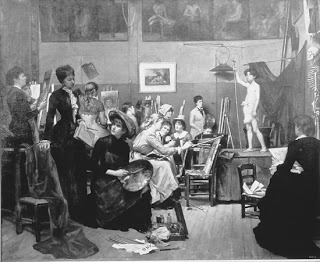
Here's my answer: "The perfect art school would nurture skill but not ostentation, knowledge but not dogma, and tradition but not conventionalism."
Blog: Gurney Journey (Login to Add to MyJacketFlap)
JacketFlap tags: Composition, Art Schools, Add a tag
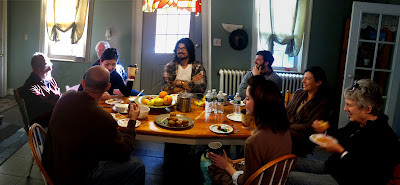
Enrollment will be limited to 15. Max will give individual critiques and studio time with live models. Garin's atelier is a congenial place to be during the work sessions and during the off-time, when students can bond around good food and conversation. There are rooms in Garin's historic house to accommodate some of the students.
Blog: Gurney Journey (Login to Add to MyJacketFlap)
JacketFlap tags: Animals, Paint Technique, Art Schools, Add a tag
I met with the editors of Dover Publishing a while ago. They publish a lot of classic books on art instruction from days of yore. I told them that most of what I know about drawing and painting comes from studying their books. They asked me for a list of my ten favorite art instruction books with a blurb about why I love each one.
Bridgman's Life Drawing by George Bridgman
Blog: Gurney Journey (Login to Add to MyJacketFlap)
JacketFlap tags: Portraits, Art Schools, Add a tag

In between giving lectures and circulating to give personal feedback, the instructors demonstrated painting techniques. Greg Manchess painted a head study of a female model in oil, with instructor Scott Fischer looking on.
Donato Giancola painted a wizard.
Iain McCaig used watercolor for a head study of a bodybuilder model who joined us last evening for a two hour pose. Since "Tarzan" was one of the five assigned topics, he was an inspiring subject.
Dan Dos Santos and I worked side by side in oil from the model, as many of the students joined in with their sketchbooks (photo by Irene Gallo).
Dan decided to shift the color range to a cool palette (left). I experimented with interpreting the same pose in an 8x10 inch oil study, and a half-hour watercolor pencil sketch in my sketchbook.
Illustration Master Class
Blog: Gurney Journey (Login to Add to MyJacketFlap)
JacketFlap tags: Art Schools, Add a tag
Massachusetts College of Art and Design is a four year art school located in the heart of Boston, Massachusetts.
The main building, which is called the "tower," has the gloom of a modernist building that wasn't designed with people in mind. But the students have decorated the interior spaces with cheerful paintings of trees and faces that humanize it a bit.
I toured the building with illustration chair Linda Bourke. There are 185 illustration students, making illustration the largest major subject.
Andy Reach, like all upper division students, gets his own dedicated workspace. It's OK if they don't keep the space tidy. "We love it when they get messy," Ms. Bourke said.
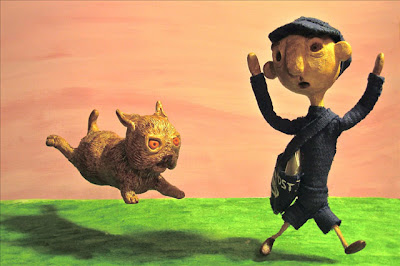
One of the most popular classes is illustrative mask making, where the students work directly with theater professionals from Boston. Students are encouraged to experiment with unconventional illustration media, such as embroidery, cutout sculpture, animation, and Sculpey. Above is a sculptural illustration by Virginia Kainamisis.
The graduating seniors put special effort into preparing their portfolio. On behalf of the students, the school produces and provides them with a set of business cards in the form of illustrated trading cards.
------
Massart web site
Blog: Gurney Journey (Login to Add to MyJacketFlap)
JacketFlap tags: Animals, Art Schools, Add a tag
Blog: Gurney Journey (Login to Add to MyJacketFlap)
JacketFlap tags: Art Schools, Add a tag
The Art Institute of Phoenix is a degree-granting institution in Arizona that focuses on developing professional skills in the fields of animation, visual effects, game design, fashion design, and culinary arts.
It's part of the Art Institute association of schools, which has over 40 branches throughout North America. I visited the school more than a year ago, and I've also visited the Art Institute Inland Empire in San Bernardino, California.
Kevin Hedgpeth is on the faculty of the media arts program. He's showing me paper sculptures of a helmet and a motorcycle made by the students. Kevin has experience in illustration, toy design, character design, and paleoart.
He likened his job as an instructor to giving the students a "Batman's utility belt," with a variety of skills that they can use in an ever-changing job environment.
After touring the building, meeting faculty, and doing a digital presentation, I did a demo portrait of Kevin.
------
Wikipedia on Art Institute Phoenix
Official website
Previously: Art Institute Inland Empire
Blog: Gurney Journey (Login to Add to MyJacketFlap)
JacketFlap tags: Portraits, Paint Technique, Art Schools, Add a tag
Two days ago, I visited Maryland Institute College of the Arts (MICA) in Baltimore, Maryland to visit the oil painting class of Patrick O'Brien and James Warhola 
My old pal James agreed to go under the lights for a portrait demo that lasted an hour and thirty minutes. As the students gathered 'round, I set up my portable pochade easel on a camera tripod.
James took off his glasses and put on an antique beaver top hat. I laid in the basic shapes with a brush on an oil-primed canvas-covered masonite panel, 9x12 inches. I premixed a few of the main colors and blocked them in with long-haired bristle filbert brushes.
With the help of one of the students, Bethany, who loves costumes, we tried to imagine how a high wing collar and a cravat might look, so as to keep to the period flavor.
About MICA
Patrick O'Brien's Maritime Art
James Warhola's website
Open Box M Pochade Box
Previously:
Tone paper portrait of Warhola
Blog: Gurney Journey (Login to Add to MyJacketFlap)
JacketFlap tags: Art Schools, Add a tag
Yesterday I visited University of the Arts in Philadelphia for the second time. The first time was in the winter of 2010, right on the eve of the historic snowstorm. I was delighted to return with all new lectures, and to meet a whole new group of students.
The head of the illustration program is illustrator and graphic designer, Mark Tocchet, who created the award-winning digital painting “Lover’s Pass,” above.
Here I am with Mark (and a reference skeleton) from the last visit.
Over the years, the school’s illustration program has been led by legendary instructors, such as Ben Eisenstadt (1906-1996) and Henry C. Pitz (1895-1976). The celebrated graduates have included Richard Amsel, Jerry Pinkney, and the Berenstains, creators of the Berenstain Bears.
The illustration program has been ranked among the top three in the nation by US News and World Report. 
In between my lectures on color and composition, I did a twenty-minute portrait of Mark with water-soluble colored pencils, while he and the students watched the projected image on the screen.
Thanks, UArts, and keep up the great work.
University of the Arts, Philadelphia
Mark Tocchet's website
Blog: Gurney Journey (Login to Add to MyJacketFlap)
JacketFlap tags: Art Schools, Add a tag
R. Ives Gammell (1893-1981) carried the torch for academic painting in mid-20th century America. He published Twilight of Painting in 1946, an argument for the value of traditional painting skills that he found lacking in the art world* around him.
Gammell makes an interesting point about art teaching:
“A painter’s training does not consist primarily in instruction as to the handling of his materials. Such knowledge is extremely important, of course, but it is not the main thing. The essential purpose of a painter’s training should be to equip him with the means of solving any problem suggested to him by his creative impulse.”
He argues that all painters must begin their inspiration with the visible world, and that “a sound tradition of painting is, perhaps more than anything else, an attitude toward the visible world, and its teaching seeks to make that world more understandable and more accessible to its disciples.”
He describes bad teaching as that which makes the student follow canned formulas for painting, or as he says, “ready-made interpretations of natural appearances and recipes for rendering them.”
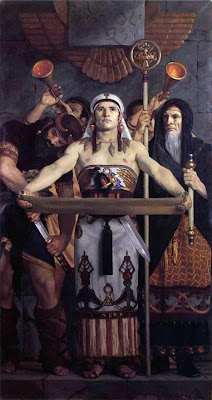
Above: Gammell: “The Law,” 1936.
How would Gammell address those higher goals? How, exactly, does the teacher equip the young painter to respond to the creative impulse? What good would such guidance be if the student didn’t already know how to stretch a canvas, and apply paint? Especially in a world where basic practical knowledge had been mostly lost, isn’t it the duty of an art education to have mastery of the mechanics of paint and brushes, perspective, anatomy, and accurate drawing?
As I understand Gammell’s argument, he would agree that it’s the teacher’s duty to help the student through all of the mechanics, which take years of dedicated effort, ideally in a small atelier.
But it’s the rare teacher that is able to equip the student with the higher tools for bringing their dreams into focus, and for manifesting them in a way that is right for that student’s unique sensibilities.
Once the practical foundation is laid, teachers can offer students proven strategies for shaping their dreams into material form. The process of developing sketches, preliminary studies from the model, and so forth, is a time-honored procedure that has served artists with all sorts of visions and styles.
*Note: Gammell’s view of the art world scarcely includes the field of illustration. Although he mentions Howard Pyle in passing, he ignores his contemporaries such as Andrew Loomis, whose Creative Illustration
Blog: Gurney Journey (Login to Add to MyJacketFlap)
JacketFlap tags: Art Schools, Add a tag
Last week I visited Columbus College of Art and Design (CCAD) to give a lecture on composition and color.
CCAD is one of the leading art schools for training illustrators, animators, painters, and sculptors. Clockwise from above left: a gallery of student work, character maquettes, Illustration chairman Stewart McKissick with a latex foam bear head, and one of the Pirate Bears made in 3-D teacher Mark Hazelrig’s class.
Mark Hazelrig teaches popular course in sculpting and casting. When we were there, students were molding soaps and designing the packages to fit them. In a back room, they were working on a giant model of a flea.
The campus buildings are scattered across a quiet section of downtown Columbus Ohio, right next to the art museum. A giant “ART” sign spans one road in the campus.
After my lecture, I did a demo portrait of Mr. McKissick. Since it was Halloween, he agreed to let me turn him into a zombie.
On the official website, the school invites you to imagine everything "from superheroes to monsters and jokes to political statements." And that's what I love about the school: the mix of wild fun, high standards, and dedicated professionalism.
CCAD Illustration website
Previously:
Coffee with CCAD illustration teacher C.F. Payne
My 2009 visit to CCAD
Blog: Gurney Journey (Login to Add to MyJacketFlap)
JacketFlap tags: Art Schools, Add a tag
“I am an aspiring fantasy artist, and I'm trying to figure out ways to move forward and get started. I would love to produce work for book covers. I am currently in the midst of a great research quest in search of information and ideas on how to get to that point.”
I told her that in my opinion, the best way to move forward as a fantasy artist would be to attend the Illustration Master Class in June in Massachusetts.
For one intense, unforgettable week, a group of about 100 students stay in the dorms of Amherst College, a quiet, leafy Ivy League campus. They eat meals together in the dining commons and stay up late looking at art books.
But mainly they work. Throughout the week, each student goes through all the steps in the process of making a picture, from preliminary sketches to gathering reference to drawing up the subject and painting the finished piece illustrating one of about five assigned topics. The students choose the topic before the class actually begins, and they arrive with initial thumbnail sketches.
There are both digital and traditional students set up in three big workrooms. Many are already at a professional level, but some are just beginning, and the atmosphere is extremely supportive and welcoming.
The group faculty offers one-on-one guidance to the students at each stage of the process. The week is punctuated by lectures, one-on-one critiques, and demos. Above are watercolor sketches I did of Dan Dos Santos and Greg Manchess. The core faculty brings their own portable studios and they each work on their own pictures right next to the students. The teachers are all really approachable people, and any of them will answer any question you throw at them.
The 2012 faculty includes the core faculty of Greg Manchess, Dan Dos Santos, Scott Fischer, Boris Vallejo, Julie Bell, Irene Gallo, and organizer Rebecca Guay. This year, Iain McCaig will be there for the week, and Adam Rex, Brom, and I are privileged to participate as visiting lecturers.

At about $2,000, the price is a little expensive, but not bad when you consider that it includes room and board, and when you realize how much you can get out of it. If you can afford it, it’s the best
Blog: Gurney Journey (Login to Add to MyJacketFlap)
JacketFlap tags: Art Schools, Add a tag
In addition to LAAFA, which I mentioned yesterday, another dynamic young art school in southern California is Korpus School of Art, founded last July by Rebecca Kimmel. I gave two lectures there last week.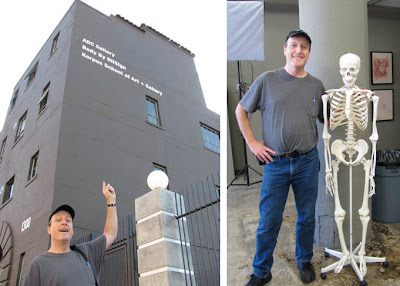
The Korpus School of Art is a small traditional atelier, occupying a single room on the third floor of a beautifully refurbished industrial building in the arts district of downtown LA.
Rebecca admires the Russian and Chinese academic figure artists, and she has a special appreciation for the old master draftsmen, especially Rubens and Pontormo. 
Her school is a great place to learn how to draw the figure, either with uninstructed figure sessions or with regular classes, where you can learn the skeleton, the muscles, and the rich tradition of figurative work.
I’ve had the privilege of visiting other small ateliers that have popped up in southern California in recent years to meet the demand for training in traditional skills of drawing and painting.
One is 3Kicks Studios in Pasadena, led by Charles Hu, himself a master of figure drawing and anatomy. 3Kicks hosts a variety of instructors and classes, including Gary Meyer, Glenn Orbik, and Richard Morris.
Another is the Watts Atelier in Encinitas, California (between LA and San Diego). Jeff Watts has a small space but a big reputation for training some of today’s top painters. He has created a friendly but disciplined atmosphere, and he brings a painterly approach to figure work inspired by Fechin, Sorolla, and Frazetta.
Though I haven’t visited them all, and can’t hope to review any of them comprehensively, there are several other excellent small schools in the Los Angeles area, such as Atelier Marchant, Concept Design Academy, Gnomon School of Visual Effects, and Red Engine School.
A student deciding which way to go with their art education, should consider whether you want an accredited degree program (often necessary if you want to teach at a university later) or whether you want to select only the classes you need to build your skills. Most art jobs look at the portfo
Blog: Gurney Journey (Login to Add to MyJacketFlap)
JacketFlap tags: Art Schools, Add a tag
Thanks to Mark Frauenfelder at BoingBoing for the nice post about my little mud puddle sketch.
For those of you in the Los Angeles area, I’ll be doing two back-to-back lectures in one evening at the Korpus School of Art next month. The date is Thursday, October 6, from 7 to 10 in the evening. 
The lectures are “Imaginative Realism: How to Paint What Doesn’t Exist” and “Color and Light.”(Faked photo above)
Since we’ve got three hours, you can ask any question you like, and I’ll try to answer it, and I’ll do a short demo following the lectures. There will be a book sale and signing to wrap up the evening. Please sign up now, as space is very limited.
Korpus event
Color and Light: A Guide for the Realist Painter
Imaginative Realism: How to Paint What Doesn't Exist
Blog: Gurney Journey (Login to Add to MyJacketFlap)
JacketFlap tags: Art Schools, Add a tag
No, I’m not dancing or directing traffic. It just looks like it. 
My wife Jeanette did these sketches while I was lecturing at the Art Institute in Phoenix last October. She used a Japanese brush pen and no lay-in, which was very brave.
I’ll be doing another lecture / demo in Los Angeles this coming October, and there is still space in the class if you’d like to join in. This is a new talk that I’ve only given once so far (at Illustration Master Class). It focuses on composition and tonal design.
My approach is unlike most others. We’ll start by looking at what science can tell us about how we actually look at pictures, both still pictures and film. Then we’ll examine how you can design images to communicate what you want in terms of mood and drama. Finally, I’ll show you some approaches to tonal organization, which I think is the most overlooked part of most compositional theory. I’ll share lots of practical tips for artists at all levels.
We’ll have a whole evening together, which gives us plenty of time for discussion and questions, and I’ll also do a technique demo and I’ll bring books. I’ve taught at LAAFA before, and admire the faculty and students there. You might want to sign up early, as space is limited, and all my workshops have sold out.
LAAFA Workshop
Color and Light: A Guide for the Realist Painter
Imaginative Realism: How to Paint What Doesn't Exist
Other classes at LAAFA from Scott McCloud, Nathan Fowkes, and Jordu Schell
Blog: Gurney Journey (Login to Add to MyJacketFlap)
JacketFlap tags: Color, Art Schools, Add a tag
We wrapped the workshop in Newburgh, New York yesterday. Three days seemed like the perfect amount of time to really dive into the subject of painting in colored light.
In the painting room, 17 artists and their easels gathered around the model stand. Garin Baker, who is sitting to my right in this picture, was the host of the home/studio venue, along with his wife Clara, who prepared delicious meals and refreshments for all the attendees. 
Here are two demos I did to explore the difference between white light and colored light illumination on the same model. The painting on the left is in watercolor 6x8 inches, and the one on the right was in oil, 9x12. Both were about two hours.
Students worked while I did demos, and I spent most of my time going around and trying to help people solve color mixing problems.
After an afternoon session of a semi-nude female model under strongly colored light, we finished the workshop painting the sunset light on the comparatively gray landscape of Storm King mountain on the Hudson River. We all were seeing new colors in the landscape, thanks to the studio practice.
Some students were experienced painters, but others were painting outdoors for the very first time, and they even endured a passing shower before the light broke magnificently.
Here was my 11x14 oil of the view. The workshop was a great learning experience for all involved, me included. Thanks to Garin and each of the students for your incredible efforts to make this a success.
Students: if you like, please post in the comment section any links to the images you did in the class.
And to others interested in future workshops: Garin is interested in expanding the vision of his atelier as a mecca for small, focused art workshop experiences. Let me ask: what sorts of workshop topics would you like to experience? Please let Garin know in the comments or vote in the poll at left.
More photos at Garin's blog
Carriage Art Atelier
Color and Light: A Guide for the Realist Painter
View Next 25 Posts



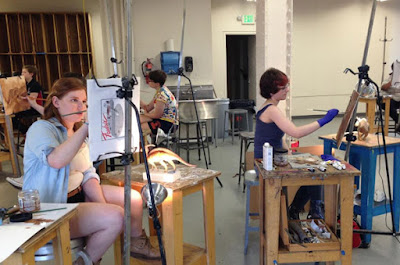
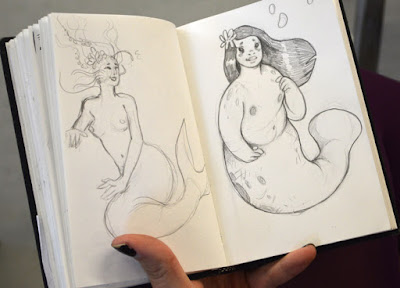
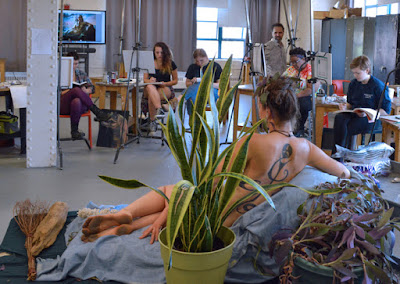
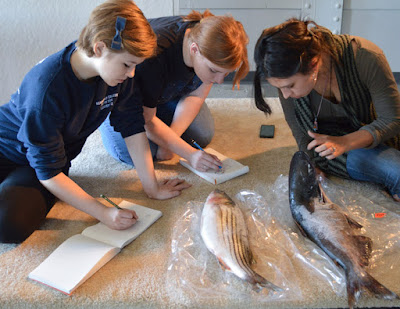
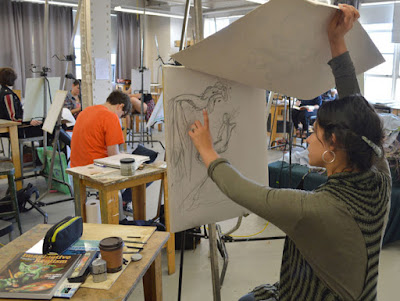
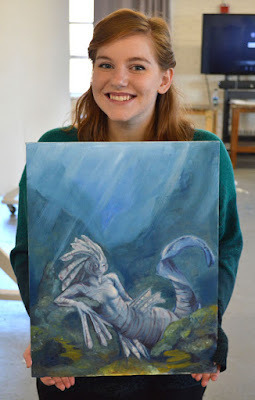





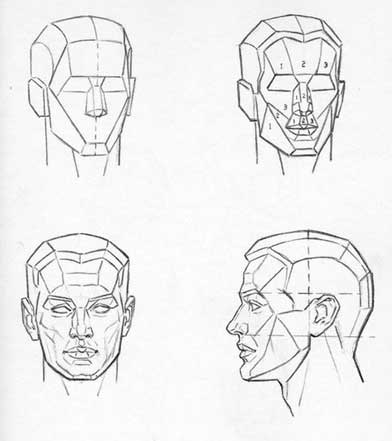


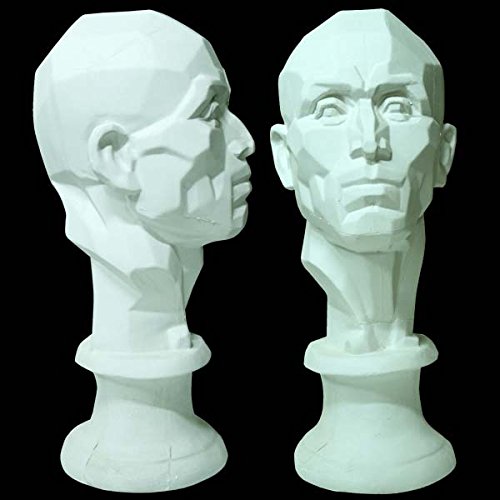
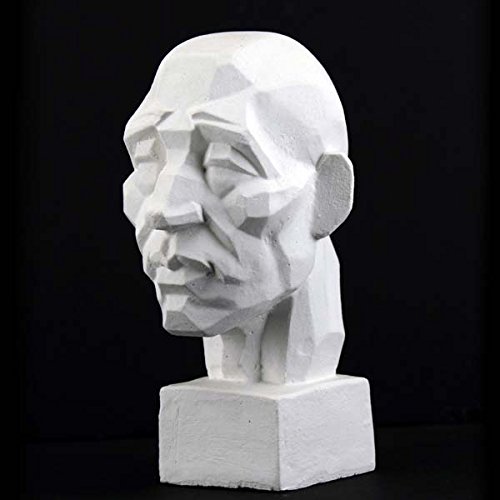

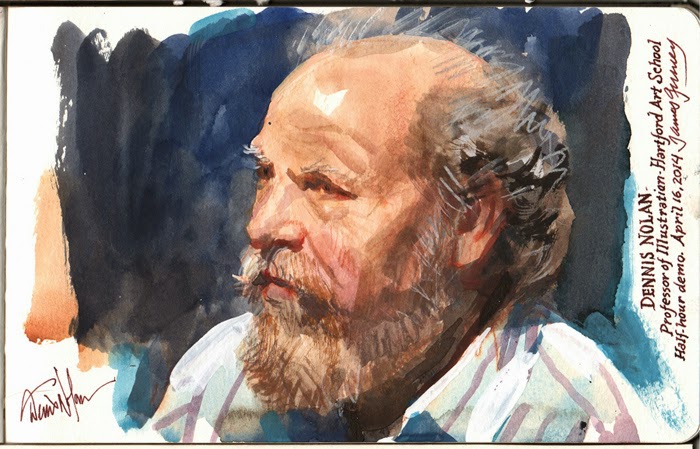
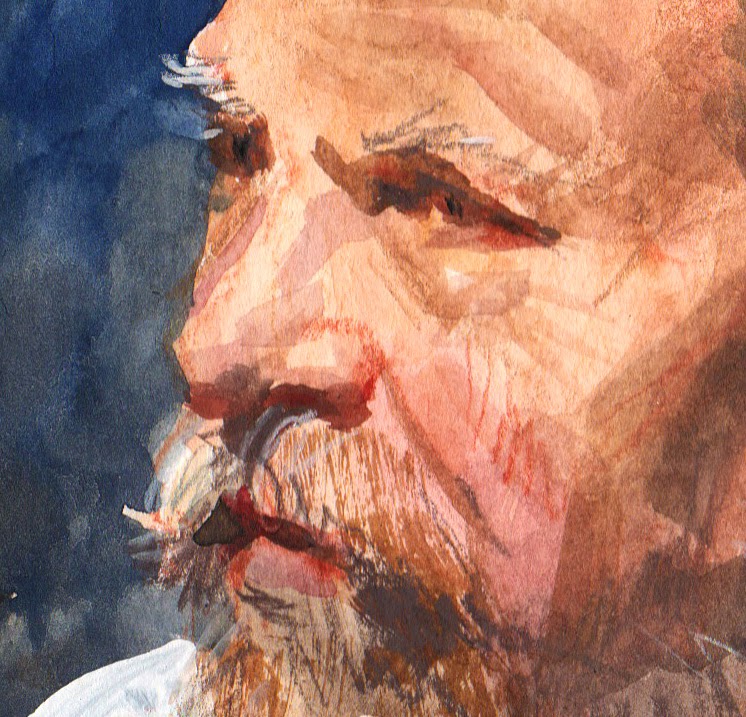
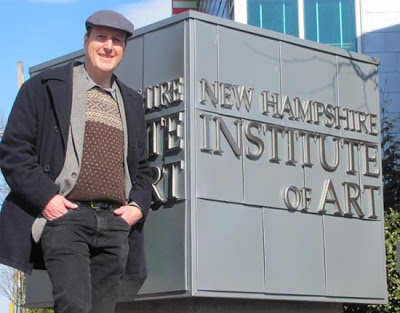
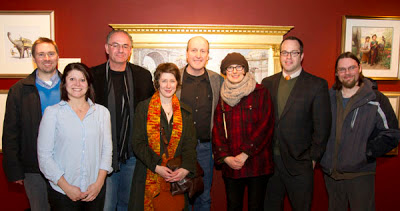
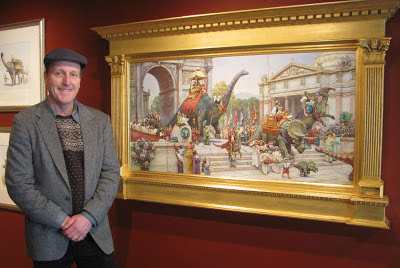
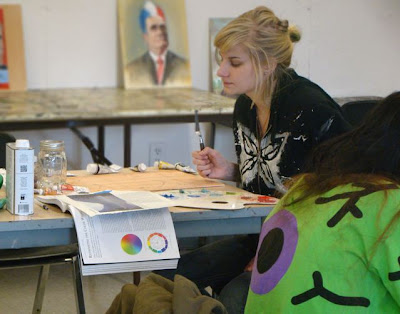
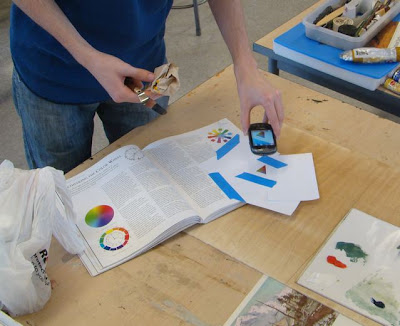
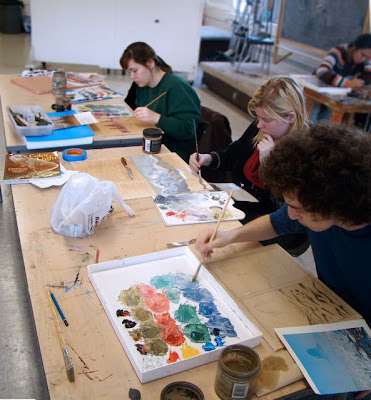
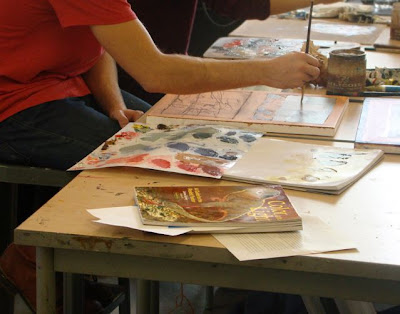
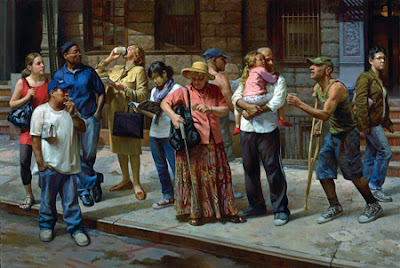
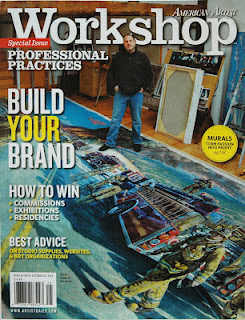
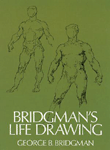
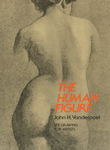
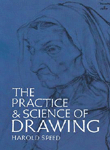
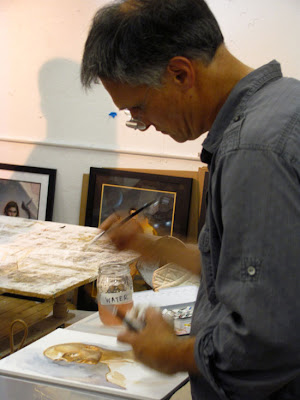

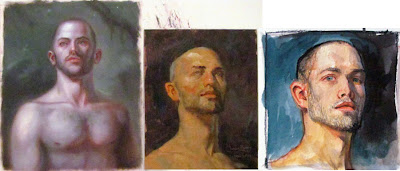


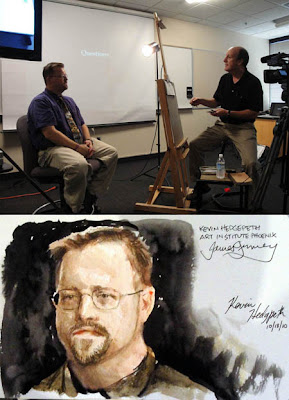
For myself, I've found that the practical skills translate over to digital applications but the reverse is rarely true. An example is learning how to sculpt traditionally before I jumped into Zbrush and started to make dinosaurs for fun.
Another thing I've noticed (again, just within my own experience) is that when it comes to learning digital tools it's really just that - learning the tool. I can figure out Sketchup within an afternoon to a competency level where I can meet most of my needs for that program, but the principles and understanding of perspective are definitely not taught to me as well. Same with other programs like Photoshop, 3DSmax, etc.
In the end, I feel it pays to learn the traditional methods first. The biggest hurdle to many digital programs is just learning the workflow and how to do things. After that, there is some digital specific things that you need to be mindful of (document resolution, colorspace, rendering/lighting settings) but ultimately it comes down to having a trained eye and knowing what you're looking for, instead of letting the tool guide you.
While advancing in new skills is good I think it would still be good to be able to use old skills as well. If something happens to the computers and we lose the ability to do things other than type with our hands we'd be in big trouble.
In measuring for proportions and learning the rules of perspective, I've learned that knowing how to do that for myself allows me to quickly and expressively brake the rules. If, for example, I see someone in the train that's interesting to draw and is 6 heads tall, to say something, I can, on the fly, decided to make him 4 heads tall for characterization. If I see an interesting perspective, but I want to exaggerate and make it a fish-eye view, I can do it on the moment, rather than wait until I upload a photo and manipulate it in Photoshop.
While the results on 3D and 2D programs are impressive and cut production time, traditional skills open a world of possibilities when inspiration strikes, which is rarely sitting in front of the computer: beautiful people, places and objects in the real world move me to draw, and those tend to be outside, away from the computer :)
Technology is just a facilitator.
It CAN'T make a non-artist into an artist.
Having said that, it CAN make an artist into a better artist.
Though I use the computer nearly every day in one form or another to help create my art, I have to say it wasn't until I decided to go back to school to learn basic drawing principles that I was able to use any of these digital tools for the sort of image making I wanted to do. That said, I've seen younger students these days who are learning these fundamentals within the digital realm, so at some point, it becomes a question of generational differences. There will always be amazing talent and artists - the tools are changing, as they have for millenia. After all, it wasn't long ago that oil painters were limited to earthy pigments and I'm sure most of us would cringe at having your rich blue pigments snatched away!
Excellent post for discussion!
I've heard that a lot of digital artists are criticized for not learning traditional skills or using a traditional approach. I think that's honestly rediculous.
Here is why: even if an artist never painted in oils or water color they all have some amount of traditional art background. That may well change in the next twenty years, but I've never met an artist working today that didn't doodle in a paper sketchbook with a physical pencil. And most all of us have used markers and crayons as children. So even if a person is all digital now. I suspect they are still building on a traditional foundation. And even if the medium is different most all the same concepts apply. There is no "make awesome art button" on my computer.
And I can honestly say sometimes rocking the pencil, or busting out the oils is honestly more fun because of its simplicity. Somtimes doing the problem solving on your own can be its own reward.
I can't believe Mr. Kooks was a cat!
When I taught basic drawing at a local trade school/trying to be a university I had to teach in a computer lab classroom. Every semester one or more student would ask why they have to learn this "crap" (or words tho that effect, usually worse) when there were computers there. What they meant was why learn how to use a pencil and paper to sketch out ideas and particularly scaling with the grid method (which they dearly hated! I gave them a very detailed Jack Kirby Captain America line drawing to scale up).
I gave them these scenarios which I had encountered in my career as an illustrator;
You are in a restaurant with a potential client pitching your solution to their problem. There's no room for a laptop (there were no tablets back then) you only have the napkins and a pen to get your ideas across. Or, you are in a boardroom in the same situation and there is a power failure. The client insists on you continuing your presentation and moves to the large windows for light and you only have your sketchbook and pencils. Get the job!
As a digital artist, I find that I use the manual skills of proportion, smoothtoning, color theory, composition, etc. all the time. They are often just subsets of the skills of observation, judgment, and draftsmanship. When we learn completely on the computer, some of these skills-behind-the-skills get lost in the translation. It's easy just to press a button and watch the computer magic. In fact, knowing those skills, I'm often tempted with just pressing a button and watching the computer magic. And I often regret those decisions.
DEFINITELY.
If teachers are running out of time - provide the information on a handout and say 'explore on your own time.'
I have plenty of time - it's getting access to the teaching and having a direction that is the most important part of teaching. I've spent HOURS drawing in a drawing class with little to no feedback from teachers. ...
other teachers, such as my prof D Koenker in Emily Carr - would look at my work and go THIS IS WHAT YOUR PROCESS IS MISSING. And even if I didn't clue in right away that is what made the difference.
I agree with Drew - I can figure out Photoshop from online tutorials but learning a good process is vital.
So yes in general. And also yes, to the more specific question of using a ruler. Computers are great for how they allow for easy editing...they are also harder to get it right on to begin with, so that editing is needed more. But being able to change something indefinite times is not that great if you don't know where you are going with the changes.
I do think it's valuable for computer artists to learn traditional skills, especially if, as is usually the case, the art work being done is still based on traditional forms.
Beyond that, I think it's even more valuable for computer artists to understand their digital tools, so that instead of thinking in terms of pressing buttons or magic, they have at least a basic understanding of how digital graphics are constructed, what algorithms all those filters are applying to the pixels, etc.
Matthew
I do both digital and traditional art. Learning traditional techniques has made me faster at the digital art. I spend less time manipulating things after the fact because, when you paint or draw, you learn to put it down right so you don't have to futz with it. I think it's possible to learn art through digital media, but I think there is something to be gained by working on a single layer with no undos.
As a knitter, I cannot agree that knitting has "no immediate practical value"!
Hena, yes, of course you're right. I couldn't survive the winter without the hats and sweaters my wife makes me. I guess I meant that most people choose to knit for other than purely pragmatic reasons, given the time involved and the cost of wool compared to the cost of machine-made woolens in the stores. Even in preindustrial societies, where everything was made by hand, people took pride in developing their hand skills beyond what was purely necessary for function, and that's one of the glories of being human.
I think, in emphasizing the importance of traditional art skills versus digital art skills, you neglected the importance on non-art-specific practical skills, such as programming or carpentry. Any skill you learn in practice will open up new artistic possibilities, whether it's simple batch programming or generating whole procedural landscapes, or it's building a simple camera stand or constructing an elaborate marionette.
"demons of curiousity" - that's a marvelous turn of phrase, and I'm going to use it as often as possible.
Back to the subject - I think there's just something about the immediacy of pencil and paper that makes them unbeatable for sketching out ideas (they're also the ultimate in portability and reliability; you can leave them in your pocket or bag and they'll be there whenever you need them, which no digital system can match)
The woman who owns the gallery where my art is shown has so few skills other than being able to paint in a particular hard edged style that doesn't express her talent fully. Because she is clumsy at filling nail holes or even removing sticky back ID cards without destroying them it costs her a lot in card replacements and professional painters and other skilled trades people . I believe every artist should be part handywoman, graphic artist, inventory keeper,etc....and computer skills are essential too ( for making your own business cards if nothing else). They all work together to give you a better chance at being a self-sufficient, and resourceful.
If one wants to be a self-sufficient resourceful artist then not only are computer skills necessary but so are handiman skills and business management know how. The artist who owns the gallery my art is at didn't even know enough to deduct cheques as she made them out. Instead she waited until they were cashed and there was no longer enough in the account to cover them!
When I was in college getting my graphic design degree we were required to take many studio classes, and we awesomely had a few electives we were able to take that could be anything as long as they were art courses. I chose for two of them to take painting classes, and of everything I did those four years those were the most useful. Learning actual oil painting is more than practical when doing digital painting. Computers are indeed just a tool, but considering there's very little difference between holding a Wacom pen and a paintbrush there's benefits to learning analog methods. I don't oil paint anymore because I don't particularly enjoy the mess that comes with it, but I take a sketchbook everywhere with me.
There's something to be said about learning to draw or paint without the benefit of an undo button.
"Do I need to teach my child to walk, even though sitting behind the wheel of a car is a much more efficent way to get around?'